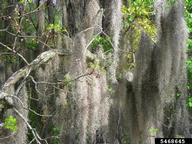Spanish moss: Difference between revisions
No edit summary |
No edit summary |
||
| Line 28: | Line 28: | ||
|} | |} | ||
== Conservation Status | == Conservation Status == | ||
[[File:.jpg|frame|center |]] | [[File:.jpg|frame|center |]] | ||
Spanish moss is listed as Least Concern. [1] | Spanish moss is listed as Least Concern. [1] | ||
[4] | [4] | ||
== Description == | == Description == | ||
Tillandsia usneoides and [[Epiphyte]][3] that typically grows on woody branches. | Tillandsia usneoides and [[Epiphyte]][3] that typically grows on woody branches. It is within the Bromeliad family of flowering plants[2] | ||
== Identification == | == Identification == | ||
| Line 41: | Line 41: | ||
== Habitat and Distribution == | == Habitat and Distribution == | ||
mmm [3] | mmm [3] | ||
== Human Uses == | == Human Uses == | ||
Spanish [[moss]] has many ethnobotanical uses. It has n=been used over the course of thousands of years as bedding, mulch, building material, and as a plant medicine in different cultures. Now it's used for aesthetics when including in floral arrangements and crafts. People also cultivate it in their gardens. As a plant medicine it is thought to help treat arthritis, diabetes, common colds, and hemorrhoids. [2] | |||
Revision as of 10:11, 30 April 2025
Tillandsia usneoides, also known commonly as: Spanish moss, Graybeard, Long moss, and Old Man's Beard.

Taxonomy
- Spanish moss is an epiphyte within the Bromeliaceae family.
| Kingdom | Phylum | Class | Order | Family | Genus | Species | |
|---|---|---|---|---|---|---|---|
| Classification | Plantae | Embryophyta | Liliopsida | Poales | Bromeliaceae | Tillandsia | T. usneoides |
Conservation Status
Spanish moss is listed as Least Concern. [1] [4]
Description
Tillandsia usneoides and Epiphyte[3] that typically grows on woody branches. It is within the Bromeliad family of flowering plants[2]
Identification
[3][4]
Habitat and Distribution
mmm [3]
Human Uses
Spanish moss has many ethnobotanical uses. It has n=been used over the course of thousands of years as bedding, mulch, building material, and as a plant medicine in different cultures. Now it's used for aesthetics when including in floral arrangements and crafts. People also cultivate it in their gardens. As a plant medicine it is thought to help treat arthritis, diabetes, common colds, and hemorrhoids. [2]
Sources
[1] Treviño Zevallos, I. 2019. Tillandsia usneoides. The IUCN Red List of Threatened Species 2019: e.T131368905A131369229. https://dx.doi.org/10.2305/IUCN.UK.2019-3.RLTS.T131368905A131369229.en. Accessed on 29 April 2025.
[2] Hand, Jr., Duke, E. R., & Florida A&M University Cooperative Extension Program. (n.d.). Spanish moss. https://cafs.famu.edu/cooperative-extension/pdf/Spanish%20Moss%20extension%20brochure.pdf
[3] Tillandsia usneoides (Graybeard, Long Moss, Old Man’s Beard, Spanish Moss) | North Carolina Extension Gardener Plant Toolbox. (n.d.). Retrieved April 29, 2025, from https://plants.ces.ncsu.edu/plants/tillandsia-usneoides/#:~:text=Tillandsia%20usneoides%20(Graybeard%2C%20Long%20Moss,Carolina%20Extension%20Gardener%20Plant%20Toolbox
[4]Vascular plants of North Carolina. (n.d.). https://auth1.dpr.ncparks.gov/flora/plant_list.php?name_sn=Tillandsia%20usneoides
[5] Spanish moss - Tillandsia usneoides. (n.d.). Ukhouseplants. https://www.ukhouseplants.com/plants/spanish-moss-tillandsia-usneoides-1